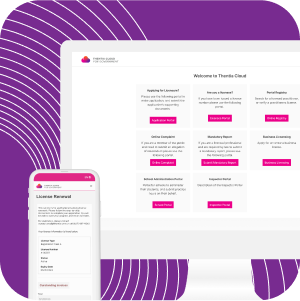- Platform
-
Solutions
-
BY INDUSTRIES
-
-
 See Thentia Cloud In Action
See Thentia Cloud In ActionSee how our platform can drive greater efficiency for your agency.
BOOK A DEMO
-
-
Company
-
COMPANY
-
LIFE AT THENTIA
-
GET IN TOUCH

-
-
Resources
-
RESOURCES
-
WATCH & LEARN
-
SUPPORT
CUSTOMER STORIES
 Hear from regulatory agencies who are using Thentia Cloud and see how it’s transformed their operations. READ MORE
Hear from regulatory agencies who are using Thentia Cloud and see how it’s transformed their operations. READ MORE
-
- Ascend Magazine
The Oklahoma Board of Architects, Landscape Architects and Registered Commercial Interior Designers (OBA) received the green light in 2019 to migrate its outdated Microsoft Access database to a secure, cloud-based occupational licensing application and renewal platform. But if you ask the agency’s executive director Leslie Hanska about the need for a digital transformation, she will quickly tell you OBA’s system and processes had been steadily aging for just shy of a decade.
Having been an employee of OBA for 22 years with a concrete understanding of how state processes have historically functioned, Hanska had long been an enthusiast for adopting a more advanced, modern solution to support the agency’s licensing operations. So when Hanska learned the state’s SQL server was no longer going to be supported, she saw a window of opportunity to bring OBA’s license application and renewal processes into the 21st century to improve efficiency for agency staff as well as end users.
But with its 96-year record of accomplishment protecting the state’s citizens by establishing standards for professional qualifications and ensuring competence through education, experience, and examinations, OBA needed a partner that deeply understood the agency’s rigorous continuing education requirements, since it oversees more than 4,000 individuals and firms with highly complex licensed professions that require not only extensive years of education, but also core areas of competency that are maintained through ongoing highly technical training.
OBA needed more than a generalized platform – it needed a partner that understood regulation and a solution with robust mechanisms to create efficiencies in both evaluating competencies and overseeing continuing education directives.
An aging renewal system in need of a lifeline
Before implementing Thentia Cloud, OBA’s nimble, all-hands-on-deck team operated all processes completely manually – from managing licensee applications and renewals to recording and validating core competency and continuing education requirements. With every renewal period came thousands of printed and mailed documents and check payments, each of which needed to be manually touched by a staff member. The process was cumbersome and time consuming for staff and lacked efficiency and user-friendliness for licensees.
“We knew our system was aging,” Hanska says. “Our clunky processes were telling us that we were desperate for change. We were truly living in the dark ages.”
When Hanska was granted permission to start evaluating service providers for the project of migrating OBA to a new digital licensing management platform, she did what many regulators do: research large, enterprise solutions. She quickly discovered that well-recognized industry providers would not only be a sizeable and unaffordable investment, but that their products were also too big for the agency’s particular set of needs. What OBA needed was a specialized solution that met their regulatory requirements.





